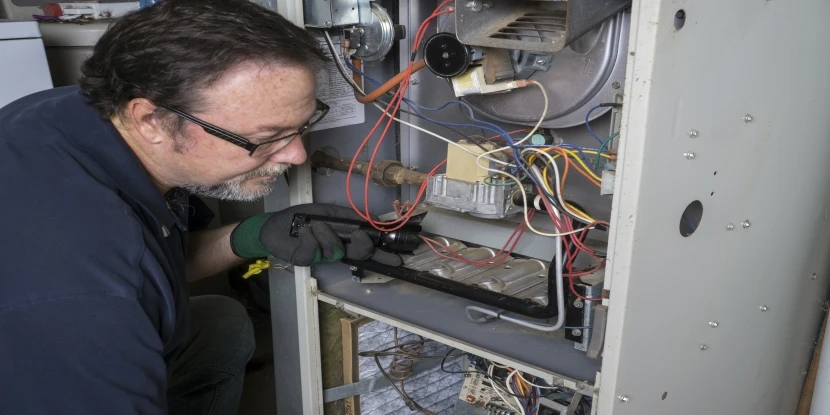How to Determine if Your Furnace is the Right Size

Few things are more frustrating than when it’s freezing cold, and your furnace can’t seem to keep up. If you’ve encountered this problem more than once, you’re probably asking yourself whether or not you have the right size furnace. It’s entirely possible that your furnace is too small for your house, which can result in a cold and uncomfortable winter for you and your family.
In this article, we’re going to take a look at how you can determine if your furnace is the right size and, if it’s not, what you can do to upgrade your system. We’ll also explain how to have the size of your furnace checked and what steps can be taken to improve its performance.
Understanding Heat Output
Furnaces come in many different sizes, with each size having a different output capability. Unfortunately, once it’s installed, you can’t add more heating capacity to a furnace. If you’re not getting enough heat or air, aside from speeding up your blower motor, there isn’t a whole lot you can do to increase output capacity.
Since the output of your furnace cannot be increased, having one that is properly sized for your home during the initial installation is crucial. If the unit that is installed is too small, when it’s really cold outside your system will struggle to properly heat your home.
Factoring the Square Footage to be Heated
Figuring out the total amount of square footage that needs to be heated for your house can be determined by measuring every room and space in your home that the system has access to. Calculate the square footage of each room (multiply length by width), then add up the room totals for your total “under heat” square footage. Here are a few tips for ensuring you get the best possible outcome for your calculations:
- Measure the square footage of every room in the house to be heated.
- Don’t include dead spaces like closets (but do include walk-in closets with heating vents).
- Measure the distance from floor to ceiling for each room, taking into account any slopes in the ceiling.
- Note any parts of the ceiling that are under an insulated attic and sections with no insulation above them.
- Measure parts of the floor that are above a basement or crawl space and which sections are on a bare slab.
Consider Your Climate
The fall and winter climate where you live will also play a major role in how much heating your house requires on a seasonal basis. Homeowners who live in warmer climates where the winters are relatively mild won’t require as big of a furnace to heat their home. If you live in an area where the winters are long and harsh, however, with frequent freezing temperatures, then installing a furnace with a little more capacity is a good way to ensure you and your family stay warm and comfortable at home this winter.
Having a furnace that is perfectly sized for your house is ideal, but if you have to choose between installing one that might be a little too big versus one that is a little too small, going bigger can help ensure you stay warm and toasty. Installing a furnace that’s a little more than what you need right now might cost a little more, but you’ll have peace of mind knowing you’ll always have enough heat to stay warm.
Estimating Your Heating Needs
Using a rough estimate to determine what size furnace your home needs can give you a better idea about whether your system is too big or too small. If your estimate determines your current unit is too small, then it might be time for an upgrade.
An estimate should combine the square footage of your home, with the BTU capabilities of a specific furnace model. Although the process starts with your square footage, it doesn’t end there (see below). Make sure to account for your climate, house layout, insulation, doors and windows, and areas of heat loss. These factors are all crucial to getting a good rough estimate of your heating needs. It’s also important to note that an estimate is just a guide, it’s always best to consult with a heating professional before making any final decisions.
Other Factors to Consider
A few other important factors to consider when trying to determine what size furnace you need include:
- Home Layout
The direction that your home faces can be a significant factor when determining your home heating needs. If your house has a southern exposure, it will typically get more sunlight throughout the day. Lots of direct sunlight can help increase the temperature inside your home as much as ten degrees, which can help keep your home warmer - even during winter months. As a result, you might be able to install a slightly smaller furnace. The size and number of windows your home has can also be a factor depending on the direction they face and how well they are insulated.
- Home Insulation
Proper insulation can be a big factor in determining furnace size. If your home is not properly insulated, that will diminish its ability to retain heat, which makes your furnace work harder to maintain a comfortable temperature. This can result in high heating bills and some chilly nights, even if your furnace is working properly. So, before making a decision on a new furnace, check your insulation to determine if any upgrades are needed. Ensuring your home is properly insulated can help you choose the right size furnace and also lower your overall heating cost.
- Windows and Doors
Although southern-facing windows and doors can help heat your home, poorly insulated windows and doors can have the opposite effect. Leaky windows and doors are the number one place your home loses heat. Updating to double-pane or insulated windows and doors will go a long way to improving the heating capabilities of your furnace and lower your energy costs. They can also mean your furnace doesn’t need to be quite as big.
- Ductwork
Heat can escape from many areas in your home. One overlooked area of heat loss is your air ducts. The air ducts transport heat from your furnace to different parts of your home. If those air ducts aren’t airtight, a lot of heat will be lost to unoccupied spaces. A test to evaluate the size and condition of your air ducts can help improve their efficiency and lower energy costs.
- Other Heat Sources
If you have other heat sources, such as a fireplace or in-floor heating, these can also reduce the need for a bigger furnace. But these added heat sources also come with some expense and maintenance. So, it’s best to speak with a heating professional before making a final decision on the size of furnace you need.
Related Topic: Sizing Ductwork – Is My Ductwork Too Narrow?
Should You Replace Your Furnace?
Depending on where you live, the winter months can be long and harsh. So, it’s a great feeling when you can get out of the cold and step into a warm, comfortable home. But if your furnace is too small, it might be struggling to keep your home warm. If you constantly feel cold inside your house, it’s time to call the heating professionals at Air Serv. We have the knowledge and experience to assess and install the right size furnace for your home. Get out of the cold and into comfort with Aire Serv! Call us today!
 Click to call
Click to call


